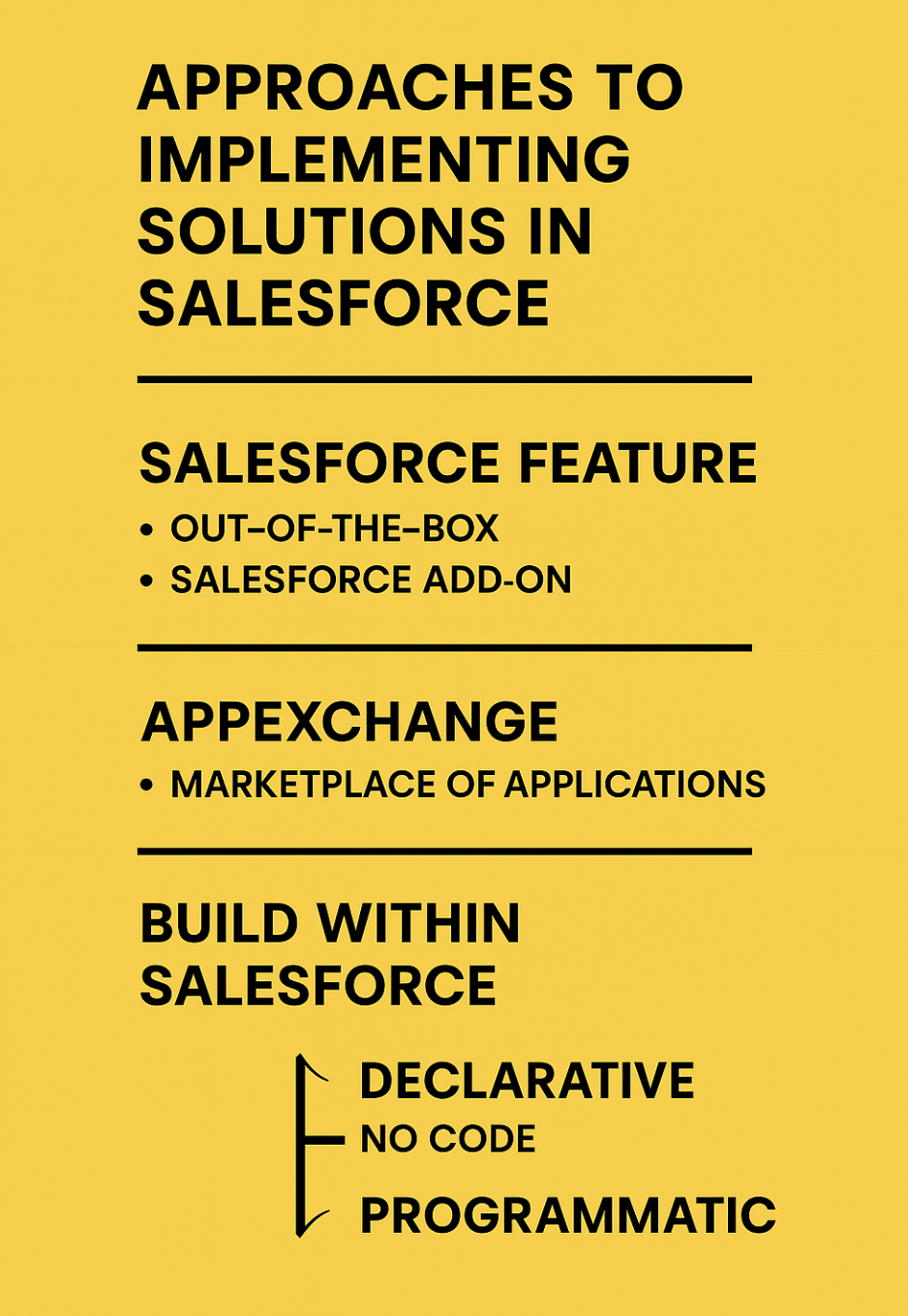When clients come to us with a Salesforce requirement — whether it’s automating a process, integrating a tool, or improving reporting — they often expect one of two things:
1. That Salesforce “already does this,” or
2. That we’ll simply “build it.”
But Salesforce is a platform, not a single-purpose app. That means there are multiple ways to approach every solution — and the right approach depends on many factors, including cost, maintainability, user experience, licensing, and total time to value.
Here’s how we approach solution design at a high level:

Three-Tier Framework for Salesforce Solution Design
1. Use Salesforce Out-of-the-Box (OOTB) Features
First, we explore whether Salesforce already provides a native, out-of-the-box feature to solve the requirement. This could include:
• Standard objects like Leads, Opportunities, or Cases
• Built-in tools like Reports, Dashboards, Activities, Reminders
• Basic automation with Flows, Validation Rules, Approval Processes
This is always the most sustainable and upgrade-safe option.
2. Consider Salesforce Add-Ons
If the base functionality isn’t enough, we explore Salesforce’s extended product family — licensed add-ons designed to work natively on the platform. These include:
• Salesforce Maps – for territory and route planning
• Tableau CRM – for advanced analytics and dashboards
• Field Service / Call Center / Service Cloud Voice – for specialized service operations
• CPQ – for complex pricing, quoting, and product configuration
These add-ons can unlock significant value but often come with additional licensing costs.
3. Explore the AppExchange or External Marketplace
If Salesforce doesn’t offer the right tool natively, we look to the ecosystem. There are two routes here:
• Salesforce AppExchange – a trusted marketplace for Salesforce-native apps (free and paid). These apps run directly on the platform and can often be configured quickly.
• External Marketplaces (like Atlassian, Zendesk, etc.) – sometimes a third-party tool is a better functional or financial fit. In those cases, we evaluate integration options to connect it to Salesforce.
This step ensures we don’t reinvent the wheel if a great solution already exists.
Only Then: We Build a Custom Solution
Custom development is always the last resort — and for good reason. Building features within Salesforce requires:
• Time and resources to develop
• Ongoing maintenance and updates
• Testing against Salesforce updates and API changes
• Monitoring for changes in third-party integrations
We divide this into two paths:
a) Declarative (No-Code) Solutions
If we can, we build custom solutions using Salesforce’s no-code tools, such as:
• Flow Builder
• Screen Flows (forms, checklists)
• Record-triggered automation
• Custom page layouts
• Notification and alerting logic
These are cost-effective, quick to deploy, and easier to maintain.
b) Programmatic (Code-Based) Solutions
When the need is complex or cannot be solved declaratively, we use:
• Apex for backend logic and triggers
• Lightning Components (LWC) for advanced UI/UX
• Custom APIs for integrations
This gives us full control — but adds long-term ownership responsibilities like regression testing and upgrade readiness.
🚧 Why Custom Code Is Always the Last Option
Custom code introduces risk:
• It must be tested after every Salesforce release (3x/year)
• It may break when third-party systems change
• It requires documentation and handover
• It can slow down org performance if not optimized
So while we can build almost anything — we don’t build just because we can. We build only when it’s the best choice.
Summary: Our Solution Design Process
When evaluating a requirement, we follow this path:
1. Can Salesforce do this out of the box?
2. Is there a Salesforce add-on that solves it?
3. Is there a third-party app or integration available?
4. Can we configure it using no-code tools?
5. Only then — should we develop it with code.
By following this process, we reduce risk, maximize ROI, and help you get the most out of your Salesforce investment — without building a solution you’ll regret later.